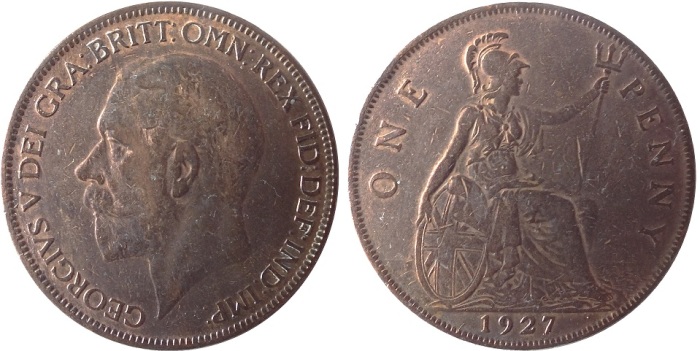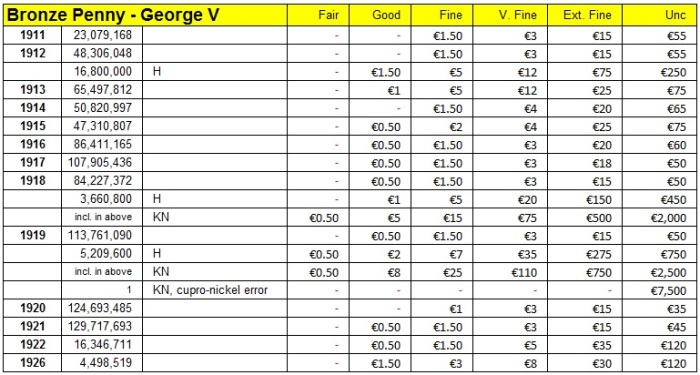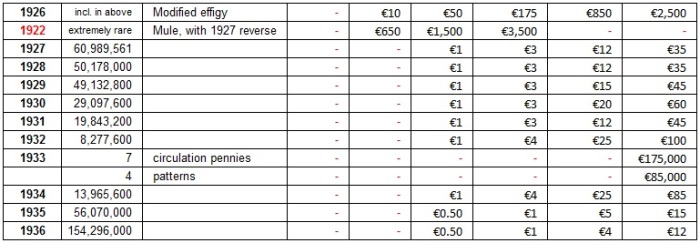Background:
Nobody thinks about British George V bronze pennies without thinking about the famous 1933 penny rarity. It is, perhaps, the most well-known British penny and many schoolboy collectors started the hobby by checking their pocket change for a 1933. Since these pennies circulated in Ireland right up until 1971, many Irish collectors also hoped they would find one too.
- O’Brien Rare Coin Review: Why is the 1933 British Penny so valuable?
There are other varieties to look out for in this reign, e.g. the H and KN mint marks from the Heaton and Kings Norton mint, respectively. There is also a unique 1919 KN planchet error struck in cupro-nickel – see link below.
- O’Brien Coin Guide: GB & Ireland (George V) Pennies Struck by the King’s Norton Mint
Bronze Penny: George V
- Alloy: Bronze (95% copper, 4% tin and 1% zinc)
- Weight: 9.4g
- Diameter: 30.8mm
- Edge: Plain
- Designers
- Obverse: Bertram MacKennal (BM)
- Reverse: Harold Wilson Parker (WP)

1911-1926 GB & Ireland, George V, Obverse Type 1, bronze penny
Obverse: Type 1 (1911-26)
- Bare head of King George V facing left,with the surrounding legend::
- Legend: +GEORGIVS V DEI GRA: BRITT: OMN: REX FID:DEF:IND: IMP:
- Full Latin text: GEORGIVS V DEI GRATIA BRITANNIARUM OMNIUM REX FIDEI DEFENSOR INDIAE IMPERATOR
- Translation: George the Fifth, by the Grace of God, King of all the Britains, Defender of the Faith, Emperor of India

1926-1936 GB & Ireland, George V, Obverse Type 2, bronze penny
Obverse: Type 2 (1926-35)
- Bare head of King George V facing left,with the surrounding legend::
- Legend: +GEORGIVS V DEI GRA: BRITT: OMN: REX FID: DEF: IND: IMP:
- Full Latin text: GEORGIVS V DEI GRATIA BRITANNIARUM OMNIUM REX FIDEI DEFENSOR INDIAE IMPERATOR
- Translation: George the Fifth, by the Grace of God, King of all the Britains, Defender of the Faith, Emperor of India
- The differences on the modified effigy are:
- The colons are further apart.
- The the border teeth are slightly fewer, wider and in higher relief.
- The initials of the engraver BM are not punctuated and the B of BM is level
with the I in IMP (they are also very faintly struck)- Freeman lists this variety as having an estimated 50,001-100,000 in existence

1926 GB & Ireland, George V bronze penny – how to identify the modified effigy
Reverse:
- Britannia seated facing right, wearing a helmet, holding a trident, hand resting on a shield, with the words ‘ONE PENNY’ in the fields, and date below.
- A lighthouse is in the background to the left of Britannia.
Mintage & Market Values:
Obverse, Type 1 (1911-26)

1911-1926 GB & Ireland, George V, Obverse Type 1, bronze penny (mintage & market values)
- “H” mint mark struck at Ralph Heaton & Sons, Birmingham – Sp#4052
- “KN” mint mark struck at Kings Norton Metal Company, Birmingham – Sp#4053
- Issues without a mint mark were struck at Royal Mint, Tower Hill, London – Sp#4051

1918 and 1919 GB & Ireland George V bronze penny mint marks
There is also a 1922 ‘mule’ penny with 1927 reverse – not sure how this came about but they are rarely seen; they are not known in the higher grades and, therefore, are likely to have come from circulation.
- This 1922 ‘mule’ is a rare variety and is well worth looking out for.
Obverse, Type 2 (1926-36)

1926-1936 GB & Ireland, George V, Obverse Type 2, bronze penny (mintage & market values)
Further Reading:
-
Penny (1d)
- Copper Pennies
- O’Brien Coin Guide: GB & Ireland Copper Pennies of George IV
- O’Brien Coin Guide: GB & Ireland Copper Pennies of William IV
- O’Brien Coin Guide: GB & Ireland Copper Pennies of Victoria
- Bronze Pennies
- O’Brien Coin Guide: GB & Ireland Bronze Pennies of Victoria
- O’Brien Coin Guide: GB & Ireland Bronze Pennies of Edward VII
- O’Brien Coin Guide: GB & Ireland Bronze Pennies of George V
- O’Brien Coin Guide: GB & Ireland Pennies Struck by the King’s Norton Mint
- O’Brien Rare Coin Review: Why is the 1933 British Penny so valuable?
- O’Brien Coin Guide: GB & Northern Ireland Bronze Pennies of George VI
- O’Brien Coin Guide: GB & Northern Ireland Bronze Pennies of Elizabeth II
- O’Brien Rare Coin Review: Why is the 1954 British Penny so valuable?
- Copper Pennies


